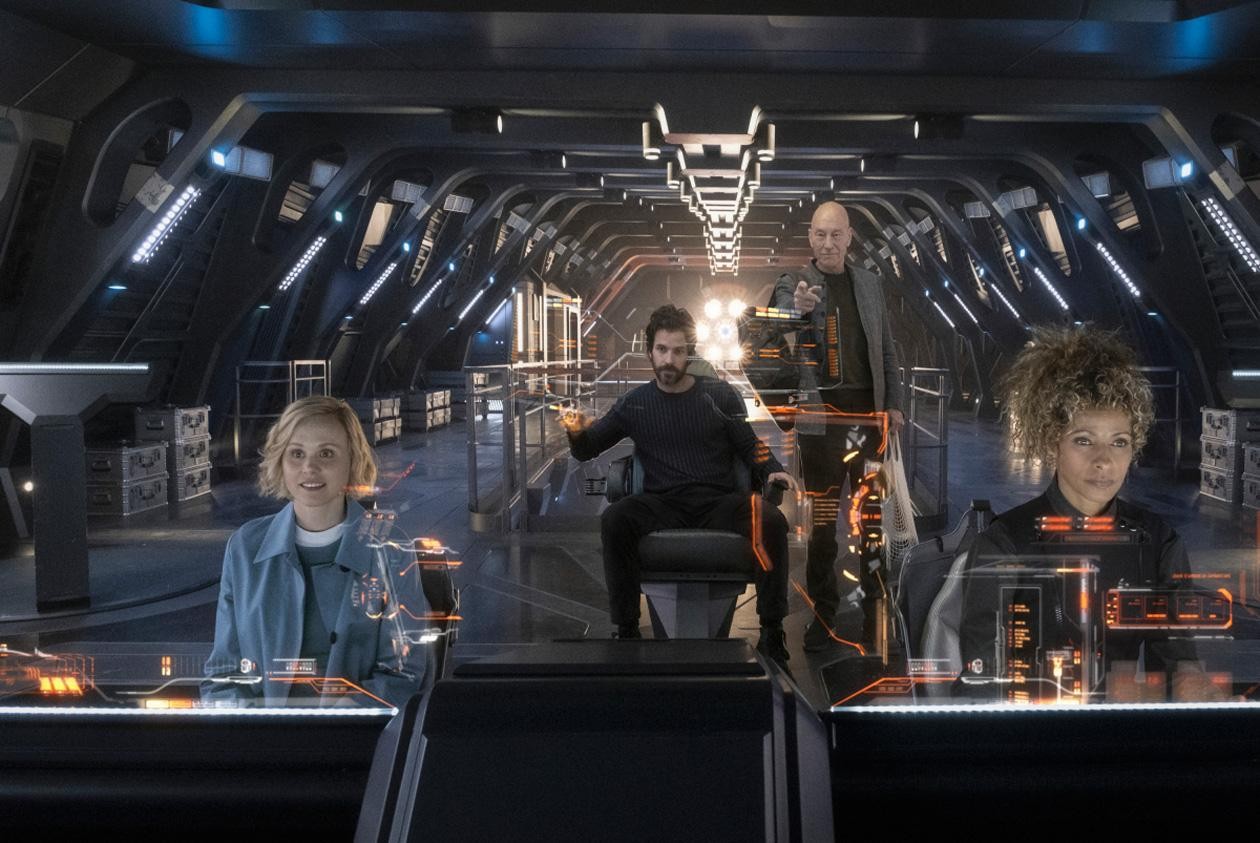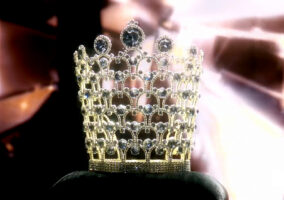
Finally! A cast emerges! A ship goes into warp! A mission is stated and acted upon! The Next: Gen theme blares for just a moment! We’re STAR TREKKING, BITCHES!
You have to figure – or at least WE do – that the creators behind this show are feeling pretty confident about the leisurely pace when they designate the third episode of the series as “The Beginning” in the episode title. In the manner of so many series in the streaming age, the first three episodes of Star Trek: Picard have quite clearly served as its prologue. Could they have started in media res, with Picard out in space and the background of the previous two decades filled in as they went along? Sure, but would that have sold the point of his age and decrepitude? Would it have allowed us to watch him go from a broken or tired man to a man standing on the bridge of a starship and intoning “Engage” with authority? As we noted in a previous review, a lot of time has passed since last we saw this world and a lot of different strands of Star Trek lore had been left untended for that time. Given everything that’s happened, everything the show is trying to coalesce, and everything it’s trying to set up so that the story feels forward moving (while also being deeply rooted in the past), we can’t really blame anyone for making the decision to take some time to get things going. The going has been a bit too slow for us, but this episode pulled things together nicely, seemingly closing out its look at the past and setting up its cast for the next phase of the story. As always with shows that follow the modern streaming model, this would have all been easier to binge-watch through it.
With a cold open flashback to 14 years ago, the show filled in some, but not all of the details on Picard’s resignation from Starfleet and his background with his former first officer Raffi. Michelle Hurd is one of those actors who feels so at home in the world of Star Trek it’s almost hard to believe she’s new to it. She brings just the right level of hammyness to the role to make her feel perfectly natural in that jazzy take on a Starfleet uniform. We can’t even tell you how many times we re-watched the scene of her doing research and reacting to holographic computer screens that, as we know, weren’t there at the time of filming. It takes some real commitment to dive into a scene like that – where you’re taking swigs from a beer and literally doing double takes at nothing – but we remained a bit in awe of her ability to really lean the hell into it. There’s no real explanation given as to why Picard turned his back on her – especially since it’s implied that he’s still friendly with his former Enterprise mates. It’s one of the few aspects of this story that doesn’t quite feel true to the character of Picard. He was commanding and rigid, but extremely warm toward and protective of his crew. But we suppose the shame of his resignation made it too difficult to maintain any sort of contact with her.
We also got the latest occupant of the captain’s chair on a Star Trek show, Santiago Cabrera as tortured tough guy Cristobal Rios. We might have found his introduction – with the cigar, the shirtlessness, and the bottle of tequila – to be more than a little eyeroll-worthy, but having Cabrera also play the various holographic crew members of his ship (each with a different accent and personality it seems) is a weird stroke of genius. And one that continues the show’s underlining of this universe’s dicey relationship with artificial intelligence. The writers have somewhat bravely removed Picard’s mystique and swagger in this world. Both Raffi and Rios are enamored of him underneath it all, but they still manage to cut him down in their interactions with him. Again, this is partially a “return to greatness” story and we have no doubt the full Jean-Luc Picard swagger will return. We figured Dr. Juratti would be joining them and are glad to see it, because Allison Pill is great here. We are sorry to see Laris and Zhaban recede to the background. She’s easily our favorite new character and that fight scene taking on the Zhat Vash agents was a lot of fun to watch in a show that’s been moving a mite slowly.
We were also treated to the long-awaited (by some folks, we guess) return of Hugh of the Borg, who is re-introduced in the most unobtrusive manner possible – without being named and looking nothing like he used to. You’d have to be familiar with the actor to even know who the character was. That’s some seriously subtle fan service Hugh, if he’s even going by that name, is the director of the Romulan-held reclaimed Borg cube. Showrunner Michael Chabon and his co-creators are showing us a post-Borg Trek universe. The Borg don’t appear to have been a threat to the Federation for quite some time (although the new recruit character from last episode did seem nervous about the possibility of their return), which would track with the final episode of Voyager, in which Captain Janeway and her crew manage to deliver the entire collective a near fatal blow. Twenty years later, the remaining Borg are, as Hugh noted, either a resource to be exploited or a danger to be imprisoned. Add a sub-community of ex-assimilated Romulans suffering extreme psychic trauma effects, the “shared mythical framework” of the Romulan ex-Borg collective that Soji’s exploring, and a secret Romulan cabal determined to wipe out all artificial intelligence and you’ve got a pretty complex, morally questionable, and utterly Trek-mythos heavy take on this world. We loved that scene with Ramdha, the Romulan Tarot reader (more or less). Romulans remain fairly under-defined even now and we felt like we got a greater understanding of their culture in the five minutes of that scene. Credit goes to Rebecca Wisocky’s performance and that eerie, watery, clearly deeply traumatized voice she deployed.
All of this is why we truly hope they don’t linger too long on Soji’s mystery. It’s the least interesting part of the show, waiting for her to figure out what she is. If they spend too much time lingering on the fact of her artificiality it will only make the series feel like it’s ripping off Bladerunner. The idea of a post-Borg galaxy in which Hugh, the former Locutus, and the former Seven of Nine are all headed on a collision course is WAY more interesting than the “I thought I was a real girl” mystery of Soji. Narek and his creepy sister (Peyton List, who does look amazing done up all Romulan, even if her “English” accent remains questionable) just aren’t all that interesting if their only reason to be in the story is to keep tabs on Soji. We’re hoping she can hook up with Picard and his crew sooner rather than later, to tackle questions more interesting than “Was Data my father?” Why did Ramdha and the Zhat Vash agent call her “The Destroyer?” What is she meant to destroy?
Whatever the future brings, we remain impressed by the intriguing, complex, nuanced and emotional story they’ve woven out of so many strands of Star Trek lore. You can argue that this darker or morally gray version of Trek is the wrong direction for the franchise, but you can’t argue that it turns its back on, to put it in Soji’s term, the “shared mythical framework” of fifty years, more than 500 episodes of television and nearly a dozen motion pictures of Star Trek. We’re deep in the weeds of it.
Oscars 2020 Countdown: Saoirse Ronan-Ology Next Post:
Kerry Washington Covers InStyle’s March Issue
Please review our Community Guidelines before posting a comment. Thank you!



